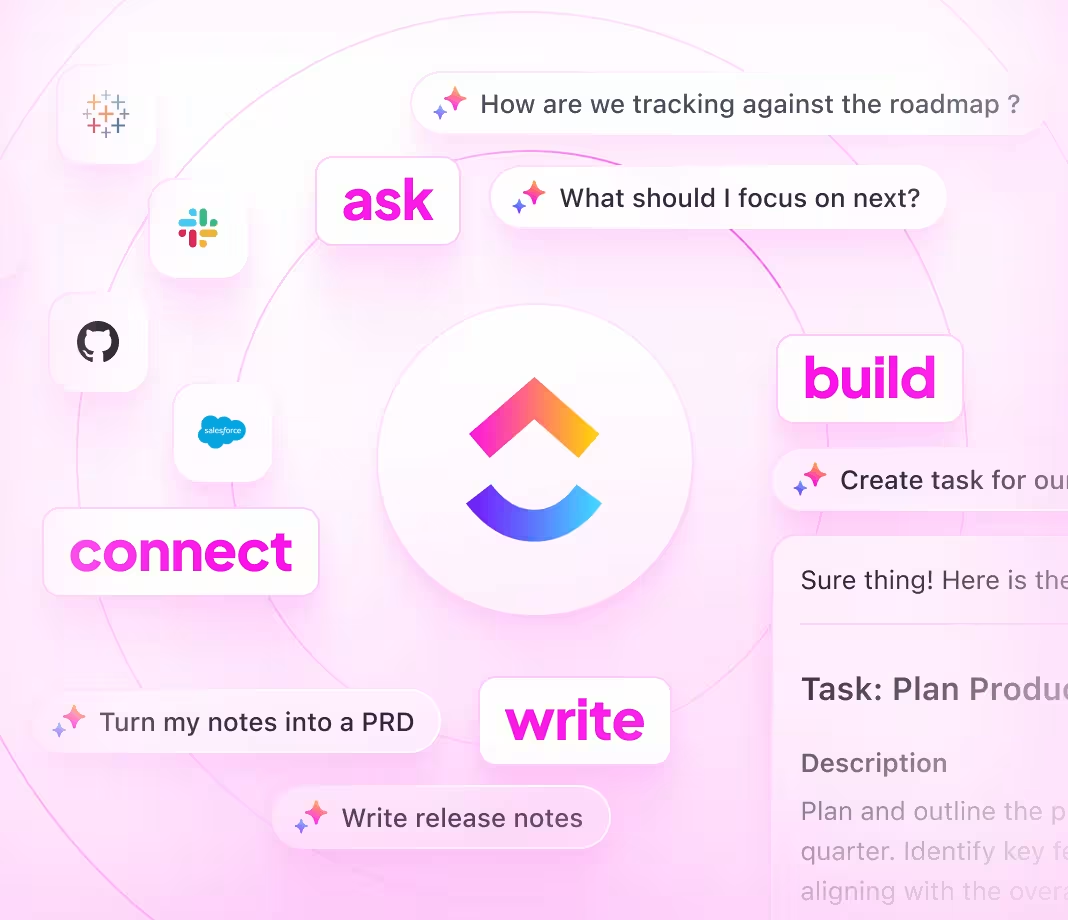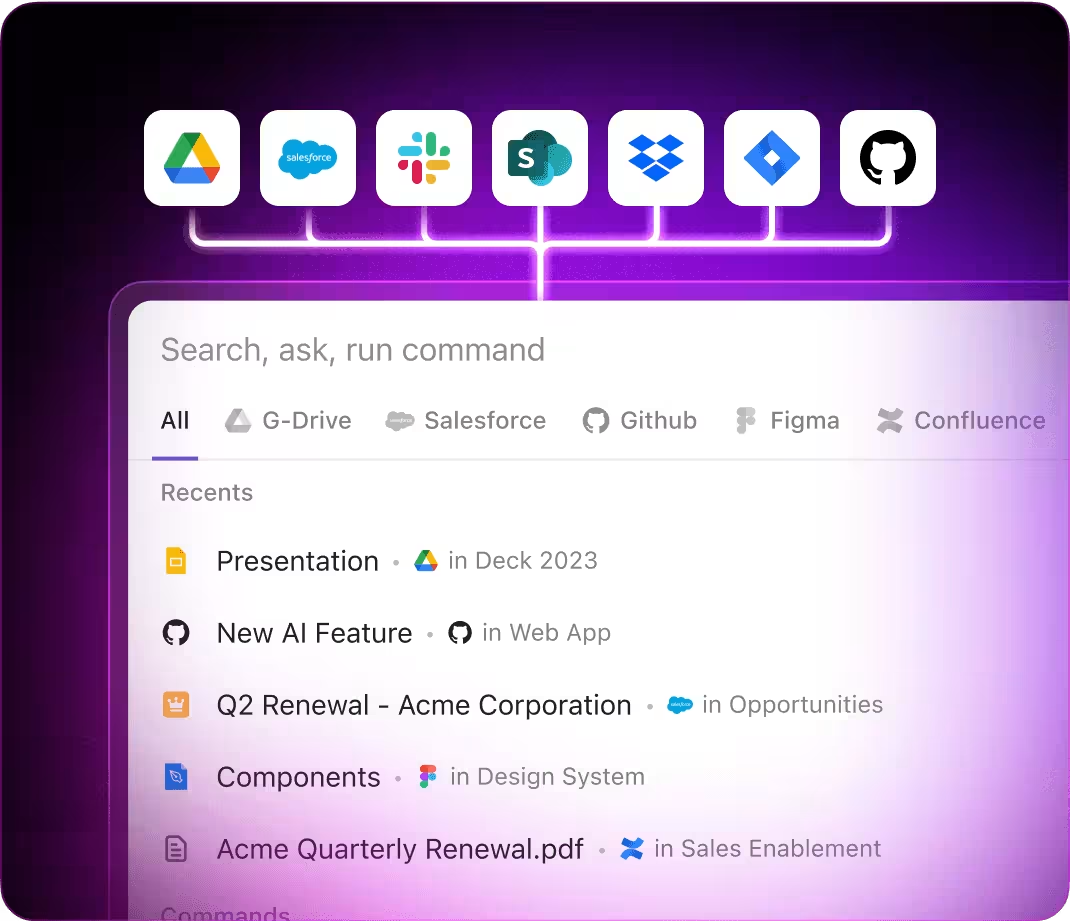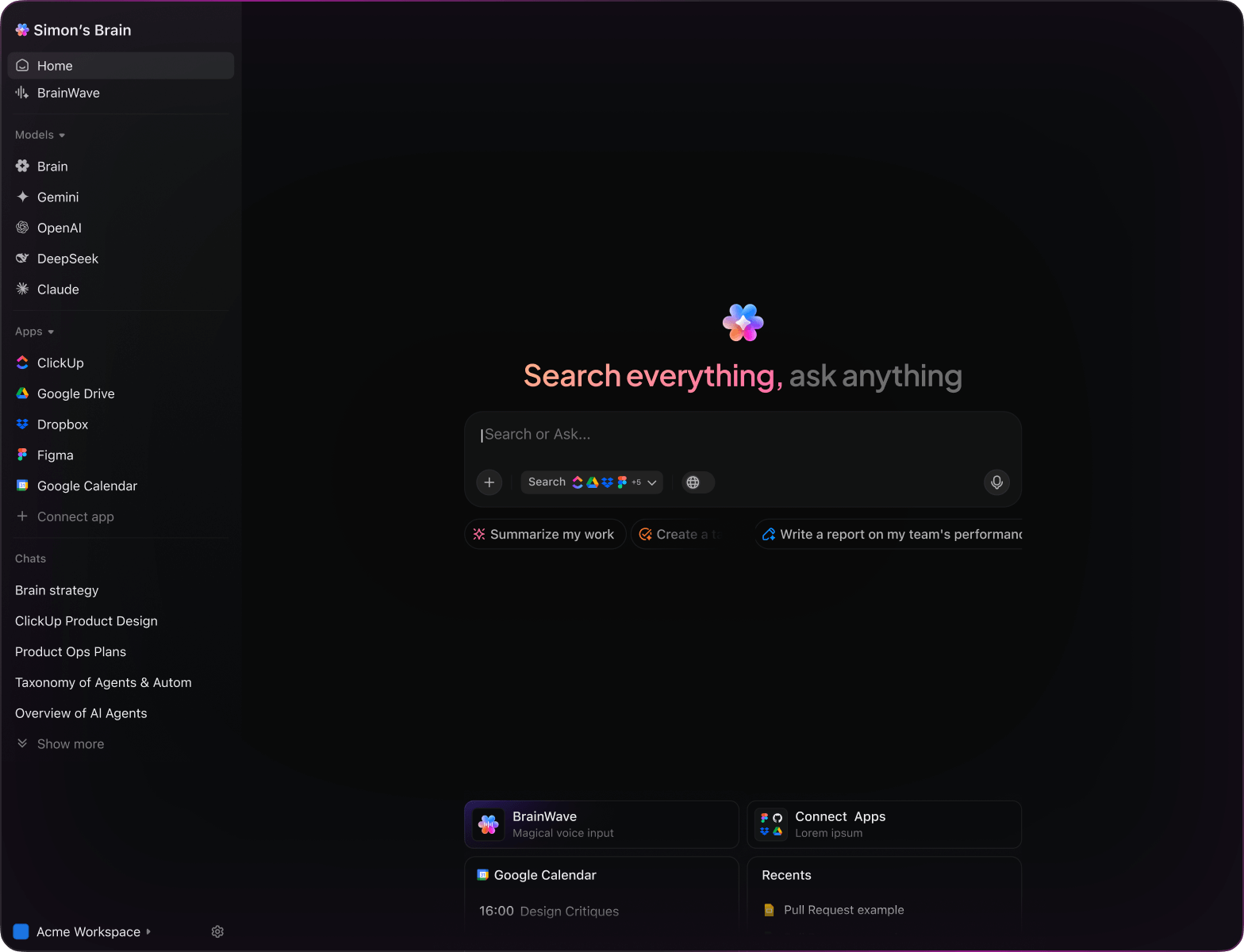AI Statistical Modeling
Top AI Prompts for Statistical Model Building
Accelerate your model development, validate insights, and enhance data-driven decisions effortlessly with ClickUp Brain.

Trusted by the world’s leading businesses
AI in Statistical Modeling
Revolutionizing Statistical Model Building with AI Prompts
Crafting robust statistical models requires precision, clarity, and efficient collaboration.
From data exploration and hypothesis formulation to model validation and reporting, building statistical models encompasses numerous steps and intricate details. AI prompts are now pivotal in streamlining these complex workflows.
Data scientists and analysts leverage AI to:
- Quickly identify relevant datasets and variables
- Generate initial model structures and assumptions with minimal effort
- Interpret validation metrics and diagnostic outputs
- Transform scattered notes into clear action plans, checklists, or project tasks
Integrated within familiar tools—such as documents, whiteboards, and project trackers—AI in ClickUp Brain acts as a proactive partner, converting your analytical ideas into structured, manageable workflows.
ClickUp Brain vs Conventional Solutions
Why ClickUp Brain Stands Apart
ClickUp Brain integrates seamlessly, understands your context, and acts instantly—letting you focus on modeling, not explaining.
Conventional AI Platforms
- Constantly toggling between apps to collect data
- Repeating your objectives with every query
- Receiving generic, irrelevant feedback
- Hunting through multiple tools to locate datasets
- Interacting with AI that only processes input
- Manually switching between different AI engines
- Merely an add-on in your browser
ClickUp Brain
- Instantly accesses your projects, datasets, and team notes
- Tracks your modeling progress and objectives
- Provides precise, context-driven guidance
- Searches across all your resources in one place
- Supports voice commands with Talk to Text
- Automatically selects the optimal AI engine: GPT, Claude, Gemini
- Dedicated desktop app for Mac & Windows optimized for performance
AI Prompts for Statistical Modeling
15 Essential AI Prompts for Building and Validating Statistical Models
Accelerate your model development—insights, validation, and refinement simplified.

Identify 5 potential predictor variables for a linear regression model predicting housing prices, based on the ‘Housing Data Overview’ doc.
ClickUp Brain Behaviour: Analyzes dataset summaries and variable descriptions to suggest relevant predictors.

What are the common assumptions checked in logistic regression models applied to healthcare data?
ClickUp Brain Behavior: Gathers key assumption checks from internal guidelines; Brain Max can supplement with external best practices.

Draft a model specification outline for a time series forecasting model using sales data from Q1 2023, referencing ‘Sales Trends’ and prior analysis notes.
ClickUp Brain Behavior: Extracts critical parameters and modeling steps from linked documents to create a structured outline.

Summarize performance metrics comparison between Random Forest and Gradient Boosting models using the ‘Model Evaluation Q2’ doc.
ClickUp Brain Behavior: Parses tabular results and textual analysis to deliver a concise comparative summary.

List top feature engineering techniques applied in recent churn prediction projects, referencing project reports and team notes.
ClickUp Brain Behavior: Scans documents to identify frequently used methods and their impact on model accuracy.

From the ‘Model Validation Checklist’ doc, generate a task list for cross-validation steps.
ClickUp Brain Behavior: Extracts validation procedures and formats them into actionable checklist items within a task or doc.

Summarize 3 emerging trends in explainable AI techniques from recent research papers and internal review docs.
ClickUp Brain Behavior: Identifies key patterns and innovative approaches from linked literature and notes.

From the ‘User Feedback Q1’ doc, summarize common concerns about model interpretability.
ClickUp Brain Behavior: Reads feedback entries and highlights recurring themes related to transparency and trust.

Write concise documentation snippets explaining the purpose of hyperparameter tuning, using the style guide in ‘DocTone.pdf’.
ClickUp Brain Behavior: Extracts tone guidelines and proposes clear, user-friendly explanations for technical content.

Summarize key regulatory requirements for data privacy impacting model training workflows as outlined in the ‘GDPR Compliance 2025’ doc.
ClickUp Brain Behavior: Condenses compliance documents and highlights critical constraints for model development.

Generate guidelines for data splitting ratios and validation strategies, referencing internal best practice docs.
ClickUp Brain Behavior: Extracts recommended procedures and formats them into a clear, actionable checklist.

Create a checklist for stress testing models using scenario analysis, based on ‘Stress Test Framework’ PDFs and project folders.
ClickUp Brain Behavior: Identifies key stress test components and organizes them into grouped tasks by scenario type.

Compare model deployment strategies like batch vs. real-time inference using competitive analysis docs.
ClickUp Brain Behavior: Summarizes documented pros and cons into an accessible comparison table or brief.

What validation techniques are gaining traction in deep learning models since 2023?
ClickUp Brain Behavior: Synthesizes recent trends from research summaries, technical notes, and uploaded reports.

Summarize key model performance gaps identified from Southeast Asia market data feedback (accuracy, bias, robustness).
ClickUp Brain Behavior: Extracts and prioritizes issues reported across surveys, feedback notes, and tagged tickets.
Accelerate Statistical Modeling with ClickUp Brain
Cut down trial-and-error, unify your analysts, and produce precise models using AI-driven workflows.






Harnessing ClickUp Brain for Statistical Model Development
Discover how ClickUp Brain enhances workflows in building and validating statistical models
Prompts for ChatGPT
- Outline a 5-step plan for constructing a regression model focusing on predictive accuracy and interpretability.
- Draft a summary explaining the importance of cross-validation in model assessment for a data science team.
- Generate three alternative feature selection strategies for a classification model and discuss their trade-offs.
- Write a detailed workflow for integrating data preprocessing and model training in a unified pipeline.
- Compare recent statistical models used in customer churn prediction and highlight key performance metrics.
Prompts for Gemini
- Propose three visualization concepts for presenting model validation results to stakeholders.
- List innovative approaches to handle missing data in large datasets with an emphasis on model robustness.
- Create a mood board description for a dashboard displaying real-time model performance metrics.
- Suggest ergonomic layouts for collaborative data review sessions and rank them by efficiency.
- Develop a comparison table of different model evaluation metrics focusing on interpretability and accuracy.
Prompts for Perplexity
- List five advanced techniques for feature engineering and rank them by impact on model accuracy.
- Provide a comparison of regularization methods for linear models, highlighting bias-variance trade-offs.
- Summarize current trends in automated machine learning and their adoption in enterprise settings.
- Generate a list of five strategies to detect and mitigate model overfitting, ranked by effectiveness.
- Compare previous model validation frameworks and extract top lessons for improving reproducibility.
Prompts for ClickUp Brain
- Transform this team discussion on model assumptions into clear validation tasks with assigned owners and deadlines.
- Summarize statistical analysis meeting notes and generate follow-up action items with priorities.
- Analyze annotated model diagnostics and produce a checklist of issues requiring further investigation.
- Create a task list from this cross-functional review on feature importance, including urgency levels.
- Summarize feedback from model deployment tests and generate actionable tasks for refinement and monitoring.
How ClickUp Supports You
Transform Initial Thoughts into Solid Models
- Convert scattered data into polished statistical models swiftly.
- Generate innovative hypotheses by analyzing previous datasets.
- Build adaptable templates to accelerate your modeling workflow.
Brain Max Boost: Quickly access historical analyses, validation results, and model documentation to guide your next statistical project.

Why Choose ClickUp
Accelerate Model Development and Validation
- Break down intricate statistical concepts into manageable tasks.
- Transform analytical insights into assignable action items.
- Automatically produce validation summaries and progress reports without extra effort.
Brain Max Boost: Instantly access historical model results, variable analyses, or dataset comparisons across your projects.

AI Advantages
How AI Prompts Enhance Every Phase of Statistical Modeling
AI prompts accelerate development and empower more accurate, reliable models.
Quickly Craft Robust Model Frameworks
Statisticians explore diverse hypotheses rapidly, refine approaches with confidence, and overcome analysis bottlenecks.
Improve Model Accuracy and Reliability
Enhance predictive power, minimize errors, and build models that stakeholders trust and understand.
Identify Flaws Early in Validation
Detect potential issues before deployment, reduce costly revisions, and ensure model integrity from the start.
Align Teams Around Clear Insights
Facilitates communication, bridges gaps between data scientists and decision-makers, and accelerates consensus.
Drive Innovation in Statistical Techniques
Encourages creative methodologies, integrates cutting-edge algorithms, and keeps your models competitive.
Integrated AI Assistance Within ClickUp
Transforms AI insights into actionable tasks, keeping your modeling projects on track and productive.
Speed Up Your Statistical Modeling
Cut down mistakes, simplify collaboration, and generate insightful results using AI support.





